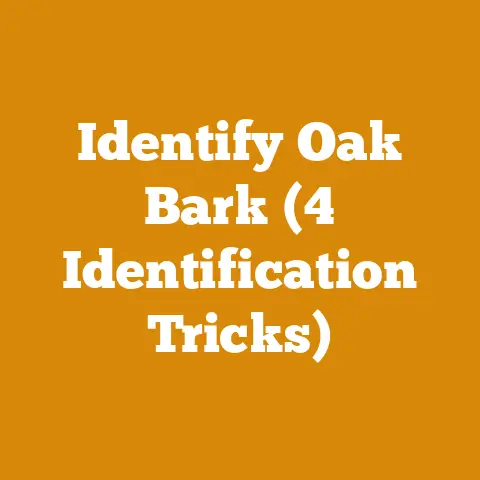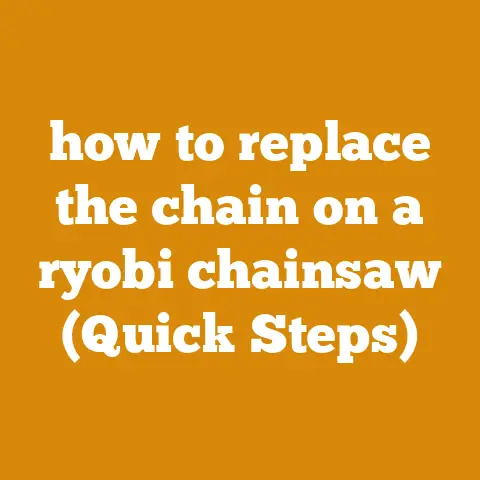Fastest Stump Removal Chemical (3 Quick Solutions)
Before tackling the task of stump removal, it’s crucial to put safety at the forefront.
Whether you’re handling chemicals or operating machinery, always equip yourself with protective gear—gloves, goggles, and sturdy boots.
Keep children and pets clear of the work area.
Now, let’s dissect the fastest solutions for stump removal using chemicals.
Fastest Stump Removal Chemical
Removing a tree stump can be quite the undertaking, but with the right approach and chemicals, it can be a smooth process.
Let’s explore three fast solutions in great detail.
1. Potassium Nitrate
I recall my initial skepticism about using potassium nitrate for stump removal.
A fellow arborist swore by it, recounting tales of speedy decomposition and easy stump eradication.
Intrigued, I decided to give it a go on a particularly stubborn stump in my backyard.
Why Potassium Nitrate?
Potassium nitrate is a chemical compound that accelerates decomposition by nourishing bacteria that break down wood fibers.
Its efficacy in stump removal is well-documented among forestry professionals.
Detailed Steps to Use Potassium Nitrate
- Drill Holes:
- Begin by drilling holes across the top of the stump.
- Aim for each hole to be about 8-10 inches deep and approximately 1 inch in diameter.
- Space the holes about 2-3 inches apart from each other.
I like to use a spade drill bit for its precision and efficiency. - Fill Holes:
- Carefully pour potassium nitrate into each hole.
- Use about 3-4 ounces per hole depending on the size of the stump.
- Add Water:
- Pour hot water into the holes to help dissolve the chemical.
- This step is crucial as it activates the potassium nitrate, allowing it to seep into the wood fibers.
Hot water truly makes a difference. - Wait:
- Allow the chemical to do its work.
- Typically, this process takes about 4-6 weeks for noticeable results.
- Burn the Stump (Optional):
- Once the stump softens significantly, you have the option to set it on fire to burn it down completely.
- Always check local regulations regarding open burning.
Safety Precautions
- Avoid inhaling any dust from potassium nitrate.
- Ensure no flammable material is nearby when burning a stump.
- Wear protective gear to prevent skin contact with the chemical.
My Experience
The first time I used potassium nitrate, I was amazed at how easily the stump crumbled after just a few weeks.
It felt like magic watching something so sturdy become so manageable with little effort on my part.
2. Epsom Salt
For smaller stumps or when I want to opt for a more natural approach, Epsom salt is my go-to.
It’s something many folks have in their home already, making it an accessible option.
Why Epsom Salt?
Epsom salt works by dehydrating the wood, which in turn speeds up decay and makes removal easier.
It’s an environmentally friendly option compared to harsher chemicals.
Detailed Steps to Use Epsom Salt
- Drill Holes:
- Like with potassium nitrate, start by drilling holes across the surface of the stump.
- Ensure they are deep enough to reach the heartwood.
- Add Epsom Salt:
- Fill each hole with Epsom salt.
- Be generous; more salt means faster results.
- Add Water:
- Pour water into each hole to help dissolve the salt.
- This helps carry the salt deeper into the wood fibers.
- Cover Stump:
- Cover the stump with a tarp or plastic sheet.
- This helps retain moisture and speeds up the decay process.
- Repeat Process:
- Every few weeks, check the progress and repeat the process until the stump becomes soft enough for removal.
Safety Precautions
- Ensure that pets and children do not ingest or come into contact with treated stumps.
- Be cautious of water runoff affecting nearby plants.
My Experience
Using Epsom salt reminded me of how patience is sometimes key in gardening tasks.
It’s less aggressive than other methods but does its job well over time.
Plus, it’s gratifying to use something so simple and natural for such an effective result.
3. Commercial Stump Remover
When I’m pressed for time or dealing with particularly large stumps, commercial stump removers are my preferred choice.
These products are specifically designed to break down stumps quickly and efficiently.
Why Commercial Stump Remover?
Commercial products often contain active ingredients like glyphosate or triclopyr that are engineered to accelerate decomposition significantly faster than natural methods.
Detailed Steps to Use Commercial Stump Remover
- Read Instructions:
- Start by thoroughly reading the product’s instructions to understand specific requirements and safety guidelines.
- Drill Holes:
- Drill holes according to the product’s guidelines.
- Ensure they are deep enough for maximum penetration of the chemical.
- Apply Product:
- Carefully fill each hole with the commercial stump remover.
- Follow any specific instructions regarding quantities per hole or stump size.
- Wait for Results:
- Adhere to the recommended waiting period for decomposition as indicated on the product label.
- Remove Stump:
- Once decomposed, remove the stump manually if possible.
- Alternatively, burning it might be an option if it’s safe and legal in your area.
Safety Precautions
- Always use according to label instructions.
- Wear protective gear, including gloves and goggles.
- Ensure proper ventilation if working in enclosed spaces.
My Experience
Commercial stump removers have been a lifesaver in scenarios where time was of the essence.
I recall one instance where a client needed a garden makeover within weeks; using a commercial product was the only viable option to meet their deadline without compromising on quality.
Equipment and Prerequisites
Equipment Needed:
- Drill with a large bit
- Safety glasses
- Gloves
- Measuring cup
- Tarp or plastic sheet (for Epsom salt method)
Prerequisite Knowledge:
- Basic understanding of drill operation
- Familiarity with handling chemicals safely
- Awareness of local regulations regarding burning
Common Questions and Concerns
Q: How long does chemical stump removal take?
A: The duration varies based on the method used and stump size—potassium nitrate might take around 4-6 weeks, while some commercial products can act faster within several weeks depending on conditions.
Q: Are these chemicals safe for my garden?
A: Generally, they are safe if used correctly, but it’s wise to avoid runoff into areas with desired plants or water sources.
Q: Can I use these methods on old stumps?
A: Yes, these methods are effective on both fresh and old stumps, though older stumps might require more time or product due to their density and dryness.
Q: Is burning necessary after chemical treatment?
A: Burning isn’t always necessary but can ensure complete removal of all debris if legal in your area.
Troubleshooting Tips
- If decomposition is slow, check if you’ve added enough water; moisture is essential for activation.
- Ensure holes are drilled deep enough for better chemical penetration.
- Reapply as needed if you notice little progress after several weeks.
Important Reminders and Next Steps
Once you’ve successfully removed the stump, consider planting grass or another tree in its place to reclaim the area aesthetically and prevent new growth from sprouting from leftover roots.
Remember that patience is key when employing chemical methods for stump removal.
With these methods, you’ll have that pesky stump gone in no time!
FAQ Section
How do I know which chemical method to choose?
Choose based on factors such as stump size and urgency—potassium nitrate for larger stumps requiring time, Epsom salt for smaller ones or eco-friendly options, and commercial removers for speed and efficiency.
Can these methods harm surrounding plants?
If applied carefully following guidelines, they should not harm surrounding plants; however, monitor water runoff especially when using commercial products.
What should I do with leftover chemicals?
Store them safely following manufacturer instructions or dispose of them according to local regulations.
Never pour unused chemicals down drains or onto soil indiscriminately.
By embracing these detailed steps and insights, you’ll effectively remove stumps from your garden or yard without hassle while ensuring safety and efficiency throughout the process.
Happy gardening!






